 Tripp Families of North America
Tripp Families of North America
Cynthia Hart
TRIPP FAMILY BURYING GROUND
The Tripp Family Burying Ground was established by Ebenezer Tripp (1710-1791), the grandson of master carpenter John Tripp (1611-1678), who landed at Newport, Rhode Island in 1630 after leaving his home in Northumberland County, England.
https://wpthistory.org/2023/06/stories-in-stone-cemetery-tour-2023/
STORIES IN STONE CEMETERY TOUR 2023
Posted on June 11, 2023 by Jenny ONeill
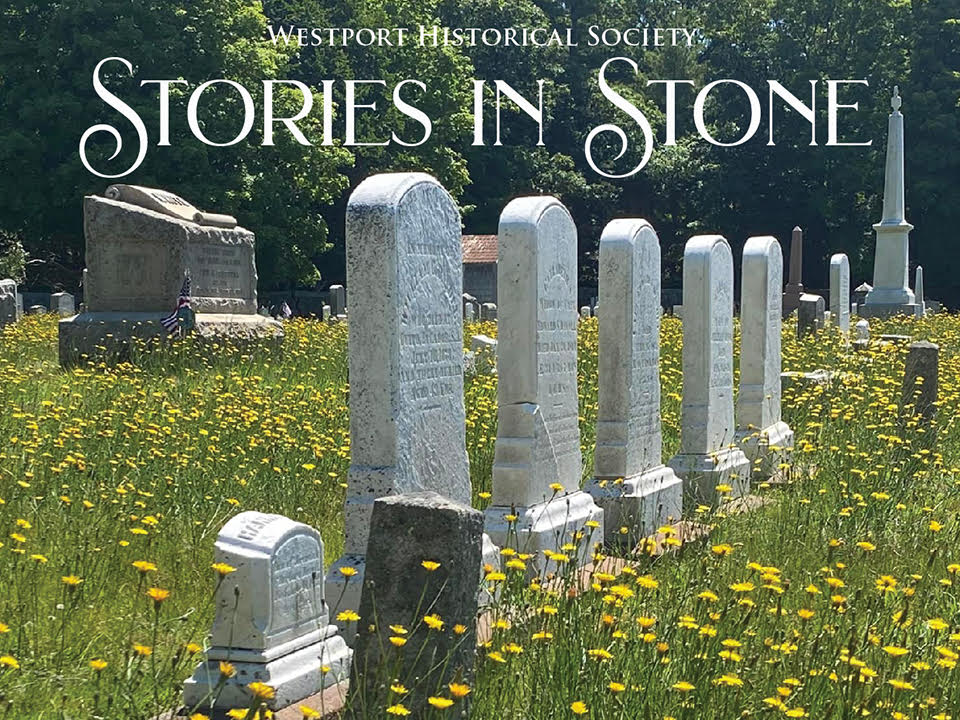 TRIPP FAMILY BURYING GROUND
TRIPP FAMILY BURYING GROUND
6 Fallon Drive, Westport MA
Research by Todd Baptista
Saving the cemetery
The Tripp Family Burying Ground was established by Ebenezer Tripp (1710-1791), the grandson of master carpenter John Tripp (1611-1678), who landed at Newport, Rhode Island in 1630 after leaving his home in Northumberland County, England. When Ebenezer died at the age of 81 in 1791, he was buried on a grassy, wooded knoll overlooking what is now Drift Road. Over the next 80 years, more than 50 members of his family and extended family would be laid to rest in the burial ground.
By the 1970s, the cemetery had fallen into disrepair and a new road, Fallon Drive, and a subdivision for a housing development was planned for the area. Permission was ultimately granted to the landowners to relocate the remains of those buried at the site through an act passed by the state legislature in May of 1975.
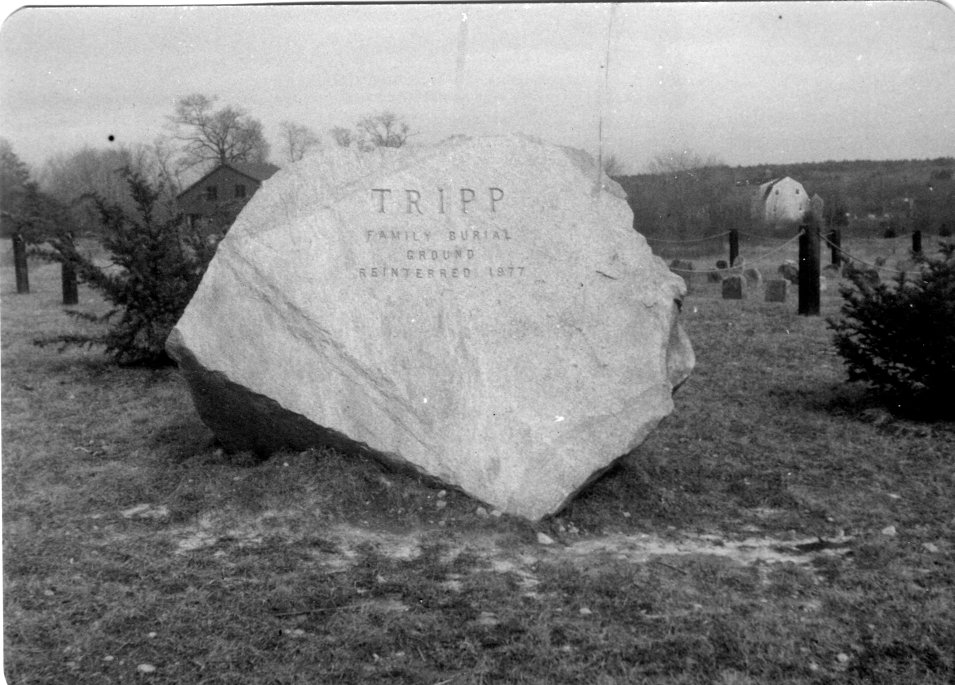
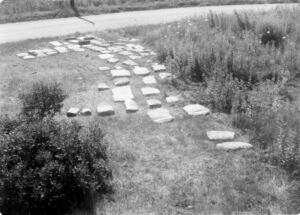
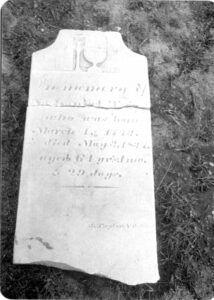
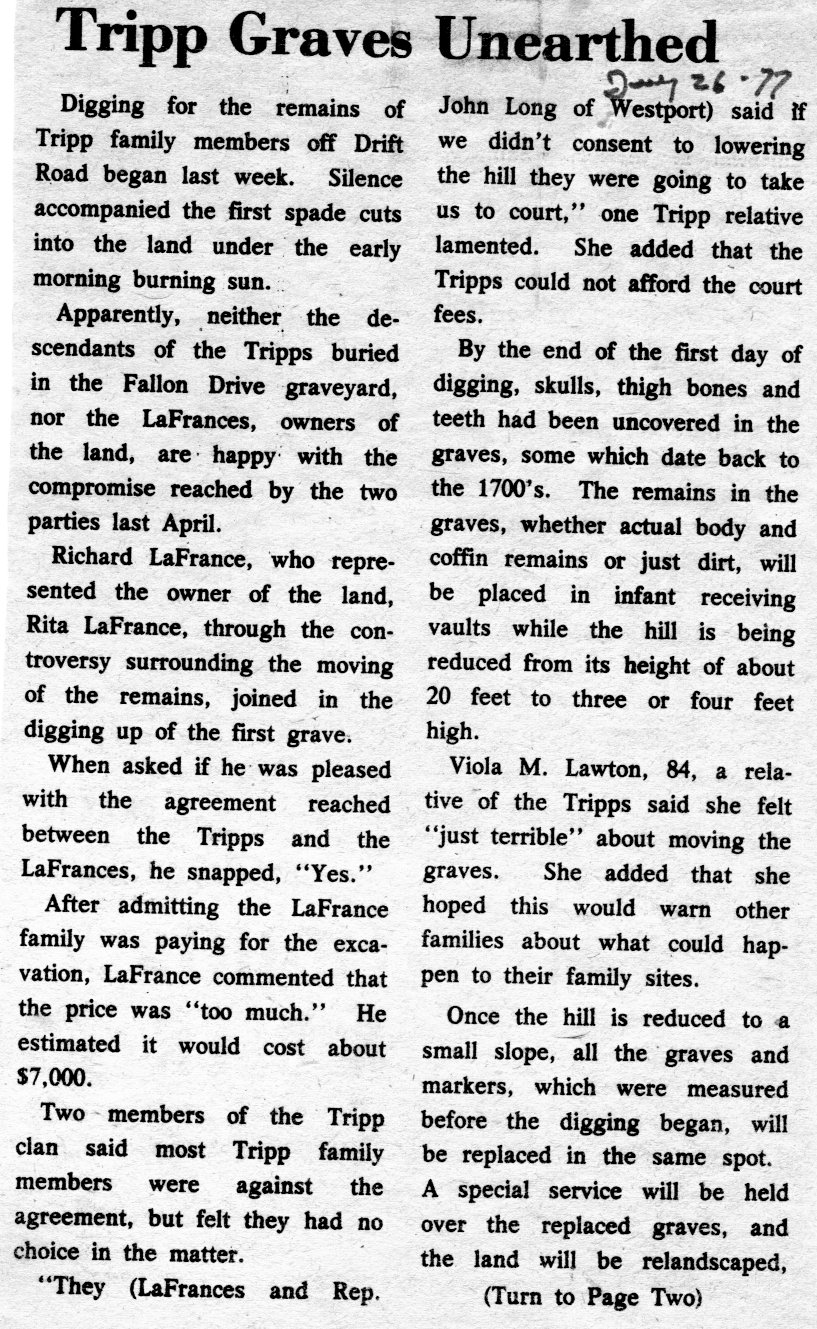 Subsequently, discussions at Town Meeting and publicity about the cemetery move alerted several generations of Tripp descendants who were unaware of the plan. Among the most vocal of the 30 descendants who opposed the action were Arnold Tripp, Ebenezer’s 5x-great grandson, and his wife, Patricia. Another family member, Norris Tripp, filed a bill calling for a repeal of the original legislative bill and reportedly planned to seek an injunction to prevent work from starting. The landowners acknowledged their mistake in not attempting to locate possible heirs and descendants and soon, both sides, eager to avoid a lengthy and costly legal battle, began working toward a compromise.
Subsequently, discussions at Town Meeting and publicity about the cemetery move alerted several generations of Tripp descendants who were unaware of the plan. Among the most vocal of the 30 descendants who opposed the action were Arnold Tripp, Ebenezer’s 5x-great grandson, and his wife, Patricia. Another family member, Norris Tripp, filed a bill calling for a repeal of the original legislative bill and reportedly planned to seek an injunction to prevent work from starting. The landowners acknowledged their mistake in not attempting to locate possible heirs and descendants and soon, both sides, eager to avoid a lengthy and costly legal battle, began working toward a compromise.
After several months of negotiation, both sides came to an agreement in February of 1977. According to news reports, the LaFrance family paid an estimated $7,000 to excavate the cemetery (about $35,000 in today’s money), remove the eroding hill, and return the remains and the gravestones to their original locations.
Fall River funeral director Mark Bearse oversaw the entire process. “By the end of the first day of digging, skulls, thigh bones, and teeth had been uncovered” one reporter noted. “The remains in the graves, whether actual body and coffin remains or just dirt, will be placed in infant receiving vaults while the hill is being reduced from its height of about 20 feet to three or four feet high.”
Before digging began, the location of all the markers was measured and documented and subsequently returned to their original sites after the work was completed. The property was landscaped and a large boulder with the notation “Tripp Family Burial Ground Reinterred 1977” was placed at the site.
This spring, the Westport Gravestone Cleaning and Restoration Group began restoration work at the site.
Who is buried here?
As was the custom among Quaker families into the early 1800’s nearly all the graves were marked with simple fieldstones. A number of them, however, were hand-chiseled with the initials of the deceased, year of death, and, in some cases, their age. The oldest surviving marker is that of Ebenezer himself, inscribed E x T 1791. The practice of marking graves with fieldstones gradually fell out of favor and, by 1850, had all but been abandoned in favor of marble tablets.
Six members of the family were interred under professionally-carved marble markers. They were Susannah Tripp (1791-1804), Potter Tripp (1802-1816), Otis Tripp (1792-1861) and his wife, Cynthia (Hart) Tripp (1788-1838), and Nathaniel Tripp (1773-1837) and his wife, Sophia (Davenport) Tripp (1770-1842).
Nathaniel Tripp and Lot R. Tripp were the two oldest children of Ebenezer (II)’s son, Ebenezer Tripp (III) (1749-1838), and the former Susanna Potter. Nathaniel and Lot had four younger siblings, Durfee, Restcome, Hannah and Alice, born between 1781 and 1792. Interestingly, when Ebenezer (III) died in 1838, he left each of his living children one dollar, except for his daughter, Hannah, who inherited his entire estate.
On December 18, 1791, Lot Tripp married Rachael Davenport, the 25-year-old daughter of Ephraim and Keziah Davenport, originally from Tiverton, Rhode Island. Two-and-a-half years later, Nathaniel married Rachael’s younger sister, Sophia Davenport. Nathaniel and Sophia had 10 children born between the years 1794 and 1814: Permilia (Gifford), Susannah, David, Alvin, Nathaniel, Melintha (Brown), Frederick, Julia Ann (Lawton), Eliphalet, and Sophia. Susannah Tripp (1796-1804) died at the age of 8 years. Hers is the oldest of the marble gravestones in the cemetery.
Nathaniel’s older brother, Lot, and his wife, Rachael, had 10 children of their own. Their fourth child- and fourth son- was named Potter Tripp. He died in 1816 at the age of 14 and he became the second member of the family to have an inscribed marble gravestone and was interred near his cousin, Susannah.
Nathaniel Tripp died at the age of 64 in 1837 and was interred in the family burying ground. His wife, Sophia, succumbed to congestive heart failure in 1843, a month before her 73rd birthday. Both were given marble gravestones.
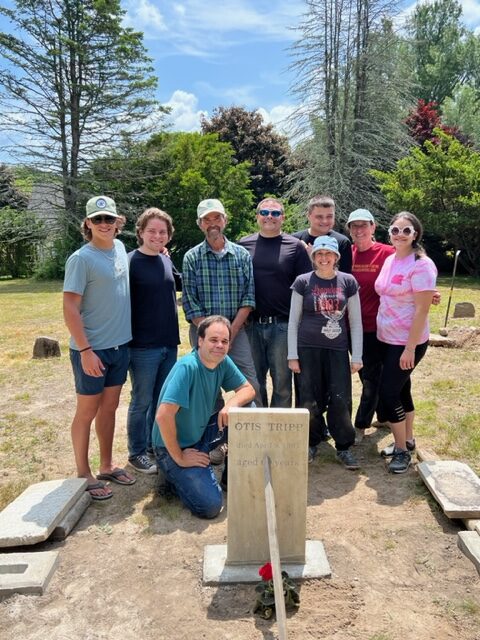
Restoring the headstone for Otis Tripp, 2023.
Their eldest son, Otis Tripp, a farmer who was born on March 5, 1792, also rests here. Otis married Cynthia Hart, the daughter of John and Ruth (Rounds) Hart. This union produced five children. Cynthia died at age 50 in 1838 and was laid to rest in the family graveyard. Otis Tripp died suddenly on April 9, 1861 at age 69. A marble gravestone was purchased for Otis for $15. Noted and recorded by historian Eleanor Tripp in 1979, Otis’ gravestone has since gone missing. The last recorded burials at the site are on fieldstones, one carved B T 1871 AG 198, and J B T 1881 age 98.
Records indicate that some of those buried under the many fieldstone markers include John A. Tripp, the son of Captain Tillinghast Tripp, who died at the age of 4 months in 1808, and the captain’s grandson, Tillinghast Weston Tripp, who was 2 years old when he died in 1844. Captain Tripp’s brother, Luthan, also a master mariner, buried his wife, Lydia, here in September of 1843 at age 68.
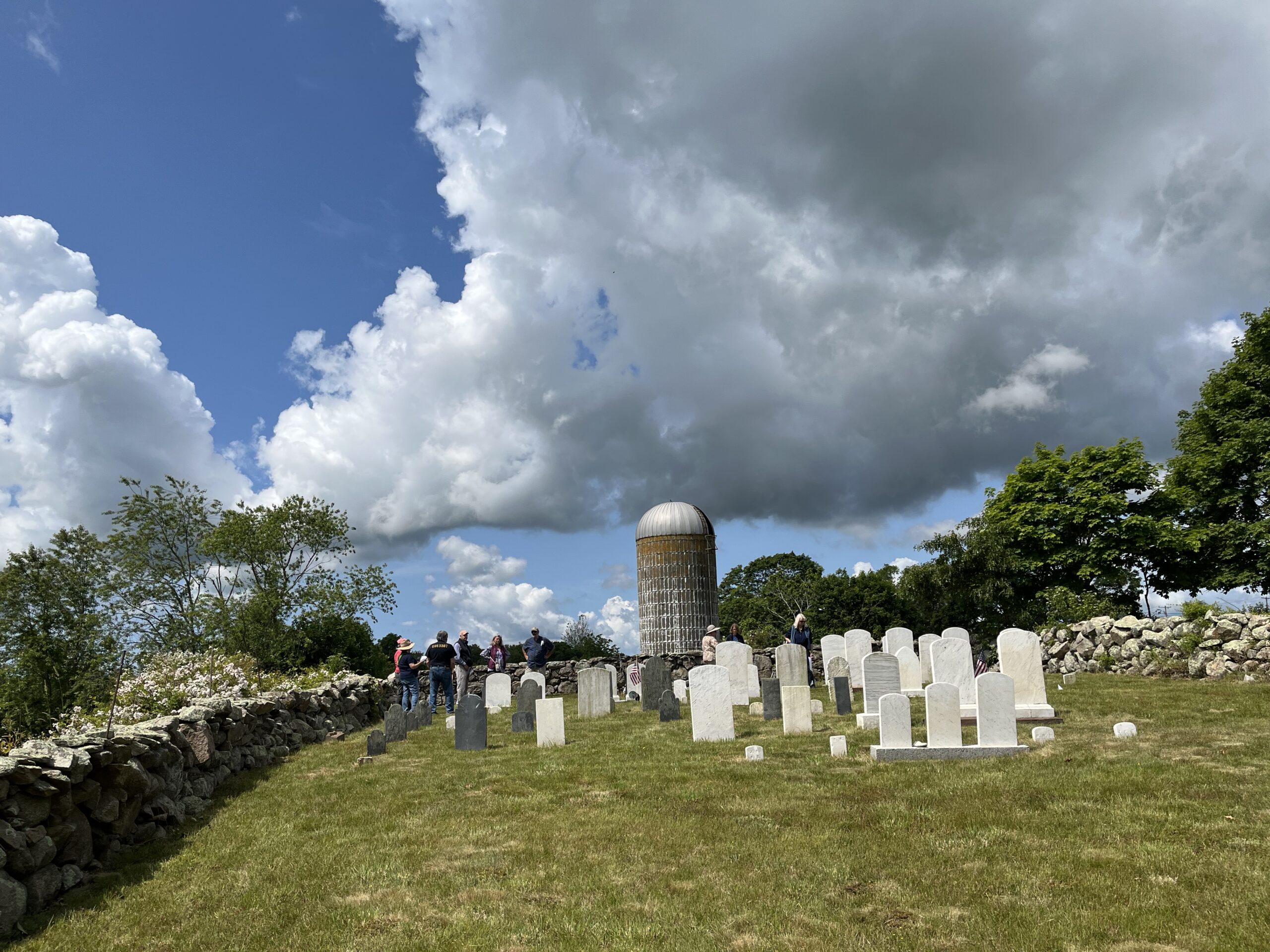
Brownell Handy Cemetery, 138 Adamsville Road, Westport MA (Research by Richard Gifford, Robin Winters and Jenny O’Neill)
This cemetery is located a short distance from the ca1700 Stokes Potter house, perhaps the oldest existing house in Westport. The property has passed through ownership of the Potters, Tripps, Brownells and Palmers. During the 20th century this was home to Oscar Palmer and his companion Eleanor Simmons. Today the property is home to Nigerian goats and Norm Anderson and Laurie Marinone. The cemetery represents families connected by marriage: the Brownells and Handys, and the Kirby and Milk families. The 70 marked graves include two Revolutionary War veterans and two War of 1812 veterans.
Doctor Ely Handy (1763-1812) and Mary Brownell Handy ( –died 1867)
Doctor Ely Handy owned the Cadman-White-Handy House (202 Hix Bridge Road and currently operated by the Westport Historical Society). He was the physician for many Westporters during the early 1800s. Although born in Rochester, Massachusetts, he married a Westporter, Mary Brownell, whose family owned the property on which this cemetery is located. Ely Handy died at the age of 49 but his wife, Mary, lived a significantly longer life, dying at the age of 95 years in 1867. His concern for the long-term care of his wife is evident in his will which stipulated the following provisions for his wife:
- one hundred dollars
- my chaise and harness and a horse to be provided and tackled in her chaise
- one half of my household goods and indoor moveables
- the use of a sufficiency of houseroom, and a comfortable support and maintenance with every necessary of life, both in health and sickness
Ely and Mary had four children, also buried in this cemetery: Polly, James, Hannah and Mira Ellet.
Doctor James Handy (1792-1868)
Dr. James Handy was a respected and compassionate country doctor known for treating many patients for free. From his account books which chronicle the treatment of many Westport residents, we know that he charged:
“$3.00 to deliver a baby, $2.00 to mend a broken leg, 18 cents to pull a tooth.”
Early 19th-century medicine did little to cure disease. Instead, drugs such as opium simply masked symptoms. Many of the drugs prescribed by Dr. Handy induced sweating, vomiting, and bleeding in an attempt to cleanse the body.
Unfortunately, James Handy was a poor businessman. It is said that he “never paid any bills and he never collected any bills.” Following his father’s death, James was left with the responsibility to care for his elderly mother and for his sisters “so long as they shall remain unmarried.” Perhaps in an effort to create additional space to accommodate the family, James built an addition at the Handy House, borrowing a large amount of money to complete the project. Sadly, the cost of this addition combined with his reluctance to repay the loan eventually brought financial ruin to his family.
Nathan Crary Brownell (1787-1861) and Hannah Borden Wilbour (1793-1839)
Nathan Crary Brownell grew up on this farm and as an adult had substantial business interests in New Bedford. In 1845 he purchased the Stone House at the Head of Westport. In 1810 Nathan married Hannah Borden Wilbour of Little Compton. Hannah’s father, Gov. Isaac Wilbour, was a man of great prominence in Rhode Island politics. Hannah’s sister was a suffragette and abolitionist acquainted with Susan Brownell Anthony and Frederick Douglass. Nathan & Hannah’s son Abner Crary Brownell (1813-1878) was a wholesaler in the Midwest and served two terms as Mayor of Cleveland, OH. Nathan & Hannah’s grandson William Crary Brownell became one of the nation’s leading literary and art critics.
Stephen P. Kirby (1815-1902) and Harriet Newell Brownell (1819-1857)
Stephen P. Kirby, whose ancestors had lived in Westport since the 1680s, was a prosperous cattle dealer. The practice in those days was for cattle drovers to bring their herds up and down local roads, stopping in front of each farm. The farmer would sell cattle to the dealer, usually milk cows who were past their prime, and sometimes in return buying a young calf whose productive life was still ahead, much in the same manner as we might trade in a used car to a dealer in exchange for a new car, with cash as boot to even up the trade. Kirby would then drive the herd overland to Brockton, where they would be sold to a slaughterhouse. Stephen & Harriet’s son Albert C. Kirby purchased the Stone House, and their Kirby descendants lived there until recent times.
Hannah Handy (1797-1892)
Hannah, the unmarried sister of James Handy, was probably born in the Handy House and lived there her entire life. Hannah never married or had children, instead she was surrounded by various generations of close family and acquaintances throughout her lifetime. These included her parents, brother, nieces and nephews, and various other individuals who lived and worked on the farm over the years. The financial dealings of her brother led to bankruptcy and the loss of the Handy House, her home. Yet the story does not end there! Through the kindness of friends and family, and through her hard work as a seamstress, Hannah Handy then aged 79, regained possession of the house. It was to remain in the Handy family until 1911. Hannah Handy died on December 31, 1892. She was 95 years old. The cause of death was simply identified as “Old Age.”
Frederick Brownell (1789-1872) and Charlotte A. Sisson (1792-1832)
Frederick ran a general store and post office at the west end of Hix Bridge. In 1814 he entered into a plan with his cousin Dr. James Handy to purchase Hix Bridge and adjoining land for $4000. Under this arrangement the deed would be filed in Dr. Handy’s name, Brownell would pay Handy $1400 immediately and the remaining $700 due Handy would be “taken out of the store.” In exchange Dr. Handy would convey to Brownell the bridge, the store and toll house, and 6 acres, with Dr. Handy retaining title to the remaining 50 acres (located across from the Handy House on the south side of Hixbridge Road). Dr. Handy ran up large bills at the store, crossed the bridge toll-free, and incurred other expenses paid for by Brownell to the total of $3,648, far in excess of the $700 agreed to as the remaining compensation. Despite repeated demands from Brownell, Dr. Handy never delivered a deed, telling him that he would get around to it in due time. In the 1870s the town of Westport purchased the bridge, in order to remove the tolls, and the estate of Dr. Handy claimed to be the owner, but after lengthy court proceedings, Brownell was determined to be the owner despite not having a deed.
Fallee Brownell (1790-1881)
An unmarried daughter of Abner & Hannah (Crary) Brownell, Fallee became a cook and housekeeper for Sylvia Grinnell Howland of New Bedford, heiress to the Howland whaling fortune.
Sylvia entrusted Fallee with the keys to her hair trunk, located in a closet and containing her financial papers. Sylvia’s relationship with Fallee earned the lifelong resentment of another member of the household, Sylvia’s niece Hetty Howland Robinson, later to become famous as Hetty Green, “The Witch of Wall Street.” In one episode, Hetty threw the elderly Fallee down a flight of stairs, resenting Fallee’s continued refusal to give Hetty access to her aunt’s trunk. Hetty nonetheless managed to forge a version of her aunt’s will more favorable to Hetty, which was thrown out by the courts. On her deathbed Sylvia told Fallee that she had provided for her in her will (a $3000 bequest) sufficient for Fallee to live on her own, as she was afraid that after her death “Hetty will never be as good to you as I’ve been,” a point on which Fallee needed little convincing.
The 1872 will of Fallee Brownell specified that her body was to be interred in the “Brownell burying ground” and that “suitable grave stones like that of my sister Dorothy should be erected on or near the spot where my body is interred.” The will further provided that the southwest corner of the burying ground should be cleared of bushes and their roots “so as to exterminate them within at least one square rod,” and that “suitable graves stones be erected for my Father’s and Mother’s graves, at a cost not exceeding sixty dollars for both graves.”
Edward B. Kirby (1847-1862)
Edward B. Kirby was the son of Stephen Kirby and Harriet Newell Brownell Kirby and was born on September 2, 1847. At age 14 he signed on as crew for a whaling voyage on the bark “John Dawson” out of New Bedford. It was his first and only voyage.
The “John Dawson” departed on May 10, 1862 and returned in 1864 but without Edward. While cruising the whaling grounds off River La Platt, South America, sperm whales were sighted off the bow. The whale boats were lowered in chase and were “stove” by the whales. All of the crew were rescued except for Edward. The logbook entry for that day has vertical whales stamped on the page which signifies whales that got away. There is also a single coffin.
It must have been very difficult for Captain Cornell to tell Edward’s father Stephen Kirby of Edward’s tragic death. Edward had celebrated his 15th birthday during the voyage and had died just before Christmas. His 5 year old brother Henry Philip Kirby had died of scarlet fever just a couple of months before Edward left on his ill-fated voyage, and Edward’s mother Harriet had died 5 years prior in 1857 at only 37 years old.
Abner Brownell (1756-1851)
On April 20,1775 Abner received word that the British were causing trouble in Boston and war had begun. He saddled his horse and galloped through Westport, calling out all the minute men in town. Within a few hours a company were on their way to Boston. Today he is remembered as Westport’s Paul Revere
| File name | Tripp Family Burial Ground-1.jpg |
| File Size | 134.45k |
| Dimensions | 955 x 685 |
| Linked to | Sophia Davenport; Cynthia Hart; Ebenezer Tripp; Lot R Tripp; Nathaniel Tripp; Otis Tripp; Potter Tripp; Susannah Tripp |
